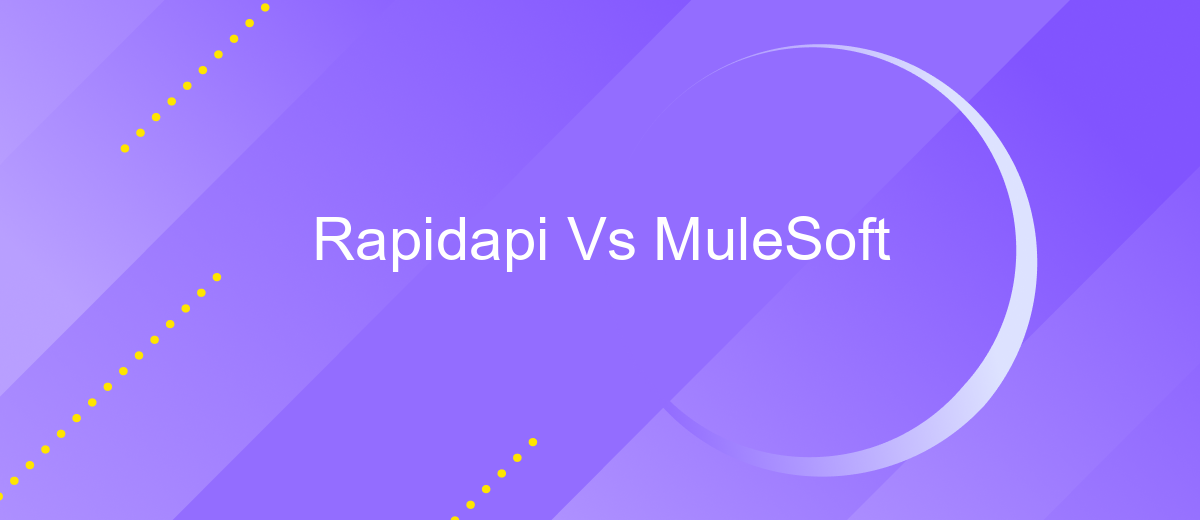Rapidapi Vs MuleSoft
In the evolving landscape of API management and integration, RapidAPI and MuleSoft have emerged as leading platforms, each offering unique features and capabilities. This article delves into a comparative analysis of these two giants, examining their strengths, weaknesses, and ideal use cases to help businesses and developers make informed decisions on which platform best suits their needs.
Introduction
In today's rapidly evolving digital landscape, businesses are increasingly relying on API integration platforms to streamline their operations and enhance connectivity between various software applications. Two prominent players in this arena are RapidAPI and MuleSoft, each offering unique features and capabilities to facilitate seamless integrations.
- RapidAPI: Known for its extensive API marketplace, RapidAPI allows developers to discover, connect, and manage thousands of APIs from a single platform.
- MuleSoft: A comprehensive integration platform that provides tools for building application networks, MuleSoft excels in connecting enterprise-level applications, data, and devices.
Choosing the right API integration platform depends on various factors, including the specific needs of your business, the complexity of your integration requirements, and your budget. Additionally, services like ApiX-Drive can further simplify the integration process by offering user-friendly tools to automate data transfer between different systems, making it easier for businesses to achieve their digital transformation goals.
Key Features

RapidAPI offers a vast marketplace where developers can find, connect to, and manage thousands of APIs. It provides a unified API management platform with features like API testing, monitoring, and analytics. RapidAPI's user-friendly interface and extensive documentation make it easy for developers to integrate various APIs into their applications quickly. Additionally, RapidAPI supports multiple programming languages and frameworks, ensuring compatibility with a wide range of development environments.
MuleSoft, on the other hand, specializes in API-led connectivity, enabling organizations to integrate their applications, data, and devices seamlessly. It offers a comprehensive Anypoint Platform that includes design, build, and manage capabilities for APIs and integrations. MuleSoft's robust data transformation and orchestration tools allow for complex integrations and data flows. The platform also provides enterprise-grade security and governance features, ensuring that integrations are both secure and compliant. For businesses looking to streamline their integration processes further, services like ApiX-Drive can be considered, offering automated workflows and easy-to-use connectors to enhance productivity.
Differences

When comparing RapidAPI and MuleSoft, several key differences emerge that can influence your choice based on specific needs and use cases.
- Purpose and Focus: RapidAPI is a marketplace for APIs, providing a platform for discovering, connecting, and managing APIs. MuleSoft, on the other hand, is an integration platform that focuses on connecting applications, data, and devices across various environments.
- Ease of Use: RapidAPI offers a user-friendly interface that simplifies API discovery and integration, making it accessible even for non-developers. MuleSoft, while powerful, often requires more technical expertise and a deeper understanding of integration principles.
- Integration Capabilities: MuleSoft provides extensive integration capabilities with a wide range of connectors and tools for complex enterprise-level integrations. RapidAPI, while versatile, is more suited for simpler API integrations. For those looking for an alternative to MuleSoft for integration needs, ApiX-Drive offers a user-friendly solution that automates data transfer between various services and applications.
Choosing between RapidAPI and MuleSoft depends largely on the complexity of your integration needs and your technical expertise. For straightforward API management, RapidAPI is ideal, while MuleSoft is better suited for comprehensive enterprise integrations. ApiX-Drive can also be considered for those seeking a simpler yet effective integration solution.
Pricing

When comparing RapidAPI and MuleSoft, pricing is a significant factor to consider. RapidAPI offers a flexible pricing model that caters to both individual developers and large enterprises. Users can choose from a variety of subscription plans, ranging from free tiers to premium packages that provide advanced features and higher usage limits.
MuleSoft, on the other hand, is known for its enterprise-level solutions, which are often accompanied by a higher price tag. MuleSoft's pricing is generally tailored to large organizations that require robust integration capabilities and dedicated support. Their plans are customized based on the specific needs and scale of the business.
- RapidAPI: Flexible pricing with free and premium plans
- MuleSoft: Enterprise-level solutions with customized pricing
For those looking to streamline their integration processes, services like ApiX-Drive can also be considered. ApiX-Drive offers a cost-effective solution for automating data transfers between various applications, making it a valuable tool for businesses of all sizes. Ultimately, the choice between RapidAPI and MuleSoft will depend on your specific needs and budget constraints.
Conclusion
In conclusion, both RapidAPI and MuleSoft offer robust solutions for API management and integration, catering to different business needs and technical requirements. RapidAPI excels in providing a vast marketplace for APIs, making it easy for developers to find, connect, and manage APIs from various providers. Its user-friendly interface and extensive documentation simplify the integration process, making it a preferred choice for smaller teams and individual developers.
On the other hand, MuleSoft stands out with its comprehensive Anypoint Platform, which offers advanced tools for API design, development, and management. It is particularly suited for larger enterprises that require a more structured and scalable approach to integration. Additionally, services like ApiX-Drive can complement these platforms by offering automated integration solutions, further streamlining the process of connecting various applications and services. Ultimately, the choice between RapidAPI and MuleSoft depends on the specific needs and scale of your project.
- Automate the work of an online store or landing
- Empower through integration
- Don't spend money on programmers and integrators
- Save time by automating routine tasks
FAQ
What are the primary use cases for RapidAPI and MuleSoft?
How do RapidAPI and MuleSoft handle API management?
Can RapidAPI and MuleSoft be used together?
What are the main differences in pricing models between RapidAPI and MuleSoft?
Are there alternatives for integrating and automating workflows without using RapidAPI or MuleSoft?
Time is the most valuable resource in today's business realities. By eliminating the routine from work processes, you will get more opportunities to implement the most daring plans and ideas. Choose – you can continue to waste time, money and nerves on inefficient solutions, or you can use ApiX-Drive, automating work processes and achieving results with minimal investment of money, effort and human resources.


